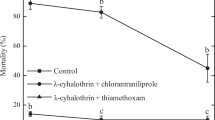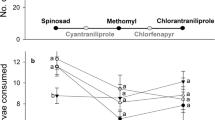Abstract
Liothrips wasabiae Haga & Okajima (Thysanoptera: Phlaeothripidae) is an important pest insect infesting wasabi (Eutrema japonicum syn. Wasabia japonica) but effective control methods are still missing. Therefore, we investigated the host range of L. wasabiae and the efficacy of chemical and biological insecticides and a physical control method (insect nets) against it. Adult thrips could not pass through nets of 0.3-mm mesh but could pass through nets of 0.4-mm mesh. The lifespan of adults reared on leaf mustard (Brassica juncea), rocket (Eruca vesicaria), and daikon (Raphanus sativus) was significantly longer compared with that of adults reared on water only (control). In host plants where feeding was longer, adult lifespan tended to be longer. The insecticides dinotefuran, nitenpyram, ethiprole, and Beauveria bassiana emulsifiable concentrate resulted in high mortality of L. wasabiae. By contrast, the mortality of B. bassiana wettable powder and pymetrozine was relatively low. Our results revealed the optimal mesh size of insect nets for suppressing invasion, the suitable hosts for long-term survival, and the efficacy of insecticides for controlling L. wasabiae. These results contribute to the development of methods to restrict the expansion and to manage the population density of L. wasabiae.


Similar content being viewed by others
Change history
26 May 2020
In the original publication of the article, the following sentence “To prevent <Emphasis Type="Italic">L. wasabiae</Emphasis> invasion of wasabi nurseries, we recommend insect nets of d males, respectively.
References
Abbott WS (1925) A method of computing the effectiveness of an insecticide. J Econ Entomol 18:265–267
Abe M, Ikegami T (2005) Susceptibility of five species of thrips to different strains of the entomopathogenic fungus, Beauveria bassiana. Appl Entomol Zool 40:667–674
Byrne FJ, Toscano NC, Urena AA, Morse JG (2007) Toxicity of systemic neonicotinoid insecticides to avocado thrips in nursery avocado trees. Pest Manag Sci 63:860–866
Food and Agricultural Materials Inspection Center (2019) Pesticide registration information provision system. https://www.acis.famic.go.jp/index_kensaku.htm. Accessed 9 Aug 2019 (in Japanese)
Haga K, Okajima S (1983) A new Japanese species of the genus Liothrips Uzel (Thysanoptera, Phlaeothripidae) injuring Wasabia japonica Matsumura. Annot Zool Jpn 56:333–337
Ishii T, Kitamura K (1975) Studies on ecology and control of the wasabi bulb thrips, Liothrips sp. (Thysanoptera): I. On life cycle, behavior and control of the wasabi bulb thrips. Bull Shimane Agric Exp Stn 13:12–29 (in Japanese with English summary)
Iwasa T, Motoyama N, Ambrose JT, Roe RM (2004) Mechanism for the differential toxicity of neonicotinoid insecticides in the honey bee, Apis mellifera. Crop Prot 23:371–378
Japan Plant Protection Association (2016) Pesticide handbook, 2016th edn. Japan Plant Protection Association, Tokyo (in Japanese)
Kodama T, Hiramatsu R, Furutani F (1978) Chemical control of thrips, Liothrips sp. feeding on the Eutrema wasabi, and residual and discharge of the insecticides. Bull Yamaguchi Agric Exp Stn 30:25–31 (in Japanese)
Kuwabara K, Takahashi M, Tadenuma M (2013) Effect of red thin thread screen for control of Thrips palmi and Bemisia tabaci in greenhouse cultivated cucumber. Ann Rep Kanto-Tosan Plant Prot Soc 60:107–109 (in Japanese)
Lewis T (1973) Thrips: their biology, ecology and economic importance. Academic Press, New York
Maienfisch P, Angst M, Brandl F, Fischer W, Hofer D, Kayser H, Kobel W, Rindlisbacher A, Senn R, Steinemann A, Widmer H (2001) Chemistry and biology of thiamethoxam: a second-generation neonicotinoid. Pest Manag Sci 57:906–913
Matsuda K, Nishijima T, Sugiyama Y, Furuki T, Sasaki D, Saito T (2018) A new distribution record of Liothrips wasabiae Haga & Okajima (Thysanoptera, Phlaeothripidae) from Chubu district, Japan. Jpn J Entomol (New Series) 21:103–105 (in Japanese)
Ministry of Agriculture, Forestry and Fisheries (2019) Pesticide Corner. https://www.maff.go.jp/j/nouyaku/index.html. Accessed in 9 Aug. 2019 (in Japanese)
Murai T (1982) Simple rearing method of thrips. Plant Prot 36:82–85 (in Japanese)
Okajima S (2006) The Insects of Japan, volume 2: the suborder Tubulifera (Thysanoptera). Touka Shobo Co. Ltd., Fukuoka
Sakai T, Tone S, Kawamura K, Suyama N (2002) Factor which influences flower-bud growth process and flower bud initiation of wasabi in field cultivation. Bull Yamaguchi Agric Exp Stn 53:41–49 (in Japanese with English abstract)
Shibao M (2013) Methods for testing the effects of pesticides on thrips. Plant Prot 67:248–251 (in Japanese)
Shibao M, Okada K, Tanaka H (2007) Occurrence of spinosad and chlorfenapyr resistance population of Thrips palmi Karny. Ann Rep Kansai Plant Prot Soc 49:85–86 (in Japanese)
Sugiyama K, Haga H, Kawamura S, Sugiyama Y (2010) Integrated pest management in wasabi. 1. Effect of BTs and a mycoinsecticide against the striated white, Pieris melete Ménétriès on wasabi, Wasabia japonica (Miq.) Matsum. Ann Rep Kansai Plant Prot Soc 52:123–126 (in Japanese)
Tsukiji R, Suzuki T (1956) A fundamental investigation on the cultivation of Wasabia japonica (1). J Jpn Forestry Soc 38:415–418 (in Japanese)
Ueyama H, Haikata M, Kataoka M, Amano H (2013) Control of onion thrips on Welsh onion by covering with a red net. Ann Rep Kansai Plant Prot Soc 55:123–124 (in Japanese)
Ugine TA, Wraight SP, Brownbridge M, Sanderson JP (2005) Development of a novel bioassay for estimation of median lethal concentrations (LC50) and doses (LD50) of the entomopathogenic fungus Beauveria bassiana, against western flower thrips, Frankliniella occidentalis. J Invertebr Pathol 89:210–218
Umeya K, Kudo I, Miyazaki M (1988) Pest thrips of Japan. Zenkoku Noson Kyoiku Kyokai, Tokyo (in Japanese)
Yamane K, Sugiyama Y, Lu YX, Lu N, Tanno K, Kimura E, Yamaguchi H (2016) Genetic differentiation, molecular phylogenetic analysis, and ethnobotanical study of Eutrema japonicum and E. tenue in Japan and E. yunnanense in China. Hortic J 85:46–54
Acknowledgements
We are grateful to Mr. Hirofumi Abe (Nihon Widecross Co., Ltd.) for providing the insect net.
Author information
Authors and Affiliations
Corresponding author
Additional information
Publisher's Note
Springer Nature remains neutral with regard to jurisdictional claims in published maps and institutional affiliations.
The original version of this article was revised due to the last sentence in first paragraph under discussion section was published incorrectly and corrected in this version.
Rights and permissions
About this article
Cite this article
Matsuda, K., Sasaki, D., Haga, H. et al. Evaluation of host plant suitability and efficacy of chemical and biological insecticides and insect nets for controlling Liothrips wasabiae (Thysanoptera:Phlaeothripidae). Appl Entomol Zool 55, 309–317 (2020). https://doi.org/10.1007/s13355-020-00683-w
Received:
Accepted:
Published:
Issue Date:
DOI: https://doi.org/10.1007/s13355-020-00683-w




